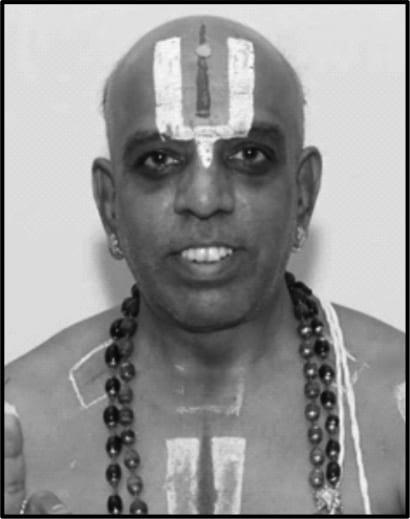Prof. M.A.Lakshmithathacharya as known to me
Mandayam Ananthanpillai Lakshmithathacharya (MAL) Swami's mother and my mother are sisters. Through his paternal lineage, as a member of the Mandayam Ananthanpillai Thiruvamsa, he is also my brother. He was one of my closest relatives and, from a young age, served as a mentor in many ways.
When my mother was pregnant with me, she stayed for a few months at her sister's (Lakshmithathacharya's mother's) house in Tirunarayanapuram. During this time, Pandita Raja Shri U.V. Azhwar Tirumala Iyengar Swami, Lakshmithathacharya's father, instructed my mother to bathe daily in the Kalyani Pushkarini, worship the Pushkarini, the Jnanasvattha tree, Jnanapiran, and serve Narasimha, who resides on the mountain. My mother followed this routine daily and returned home only after attending the Bhagavad-Vijaya Kalakshepam conducted by Alwar Tirumala Iyengar Swami. She would take food only after completing these rituals. Lakshmithathacharya often said that it was because my mother followed these practices that I became deeply involved in sampradaya (tradition) matters later in life.
When Swami moved to Chennai for higher studies in his youth, he stayed in Triplicane for a few years. There, he gathered young boys from the neighborhood and began teaching them Sanskrit. I started learning Sanskrit from him as a child, and he was the one who introduced me to the language. This sparked my interest in studying Sanskrit as a special subject when I was in the tenth grade.
Swami was an alumnus of Vivekananda College, Chennai, where he excelled in Sanskrit and graduated as a gold medalist. During this time, he also undertook the Sri Bhashya Bhagavad-Vishaya Kalakshepam under Karapangadu Venkatacharya Swamiji. After completing his studies, he returned to his hometown and became a professor at Bangalore University. Despite his academic responsibilities, he remained steadfast in observing his Vedic rituals, going to the university wearing Thiruman, Kutumi, Panchakacham, and Jippa.
Inspired by his example, I pursued a B.A. and M.A. in Sanskrit from the same college. At that time, Professor V.R. Rajagopalan headed the Sanskrit department and often praised Swami's hard work and talent. He encouraged me to follow in Swami's footsteps. Shortly after completing my post-graduation, Professor Rajagopalan appointed me as an assistant professor at Vivekananda College. Like Swami, I too went to college adhering to Vedic traditions. Professor Rajagopalan used to say that I resembled a twin of Lakshmithathacharya in my dedication and demeanor.
Although Swami was working at Bangalore University, he had a great desire to establish a Sanskrit institution in his hometown, Tirunarayanapuram. He meticulously planned its layout, designed the buildings, and identified a site for the institution. I recall accompanying him to the site—a rugged and inaccessible terrain. While I doubted its feasibility, Swami envisioned its potential with great conviction. A few years later, the land was leveled, a small building emerged, and the Sanskrit Research Institute was established. Over time, the institution grew significantly, gaining global recognition, all thanks to Swami's foresight and tireless efforts.
He often encouraged me to start a similar initiative in Chennai. However, I expressed my inability to replicate his accomplishments, citing the challenges of securing cooperation and resources in Tamil Nadu. Despite my hesitations, the Department of Vaishnavism was established at the University of Madras in 1984, thanks to Bhagavan's will. Senior advocate Sriman N.C. Raghavacharya urged me to join and develop the department. Leaving Vivekananda College, I joined the University of Madras and took on the responsibility of building the department.
Under the guidance of Professor Narasimhachariar, who entrusted me with full responsibility, I made significant contributions to the department's growth. Swami continued to guide me in various aspects, such as designing courses, organizing research programs, and conducting seminars. His expertise extended to modern technologies, including computers, which he encouraged me to use for publishing books.
Swami was instrumental in publishing several books and research papers through the Melkote Sanskrit Research Institute. He provided invaluable advice on accessing grants from the University Grants Commission and helped publish manuscripts such as Tattvavivekam by Pillai Lokacharya and Nambillay Ayyarappa Vyakyanam.
One of Swami's notable works is his magnum opus, Melkote Through the Ages, a comprehensive history of Melkote from ancient times to the present. He often encouraged me to write a similar book titled Triplicane Through the Ages to document the history of Thiruvallikeni, its temples, institutions, and notable personalities. While I have yet to accomplish this, Swami's vision continues to inspire me.
Even in his eighties, Swami remained as active and creative as a young man, regularly traveling to Srirangam to attend Bhagavad-Vishaya Kalakshepam. Despite receiving prestigious awards, including the President's Award, he remained humble and approachable, endearing himself to scholars and children alike.
Swami's vast knowledge encompassed diverse fields such as botany (Vriksha Shastra), zoology (Mruga Shastra), Ayurveda (Vaidya Shastra), culinary science (Ahara Shastra), calligraphy, and modern scientific advancements. Fluent in Kannada, Tamil, Telugu, Malayalam, and English, Swami was truly a polymath.
To many, modern malls are places where one can find everything. Similarly, Swami was a treasure trove of wisdom, always ready to provide solutions and guidance in any field.
